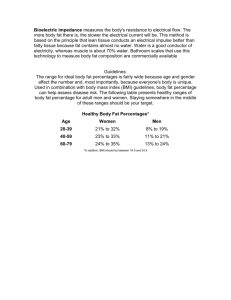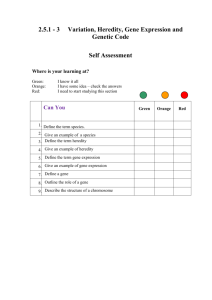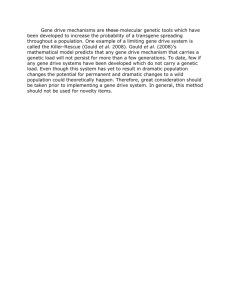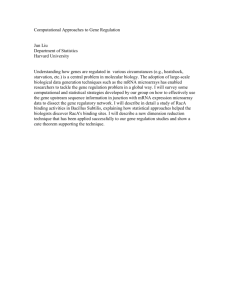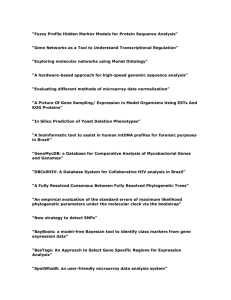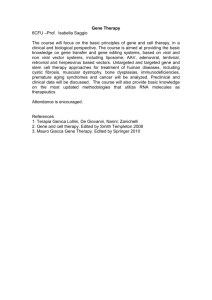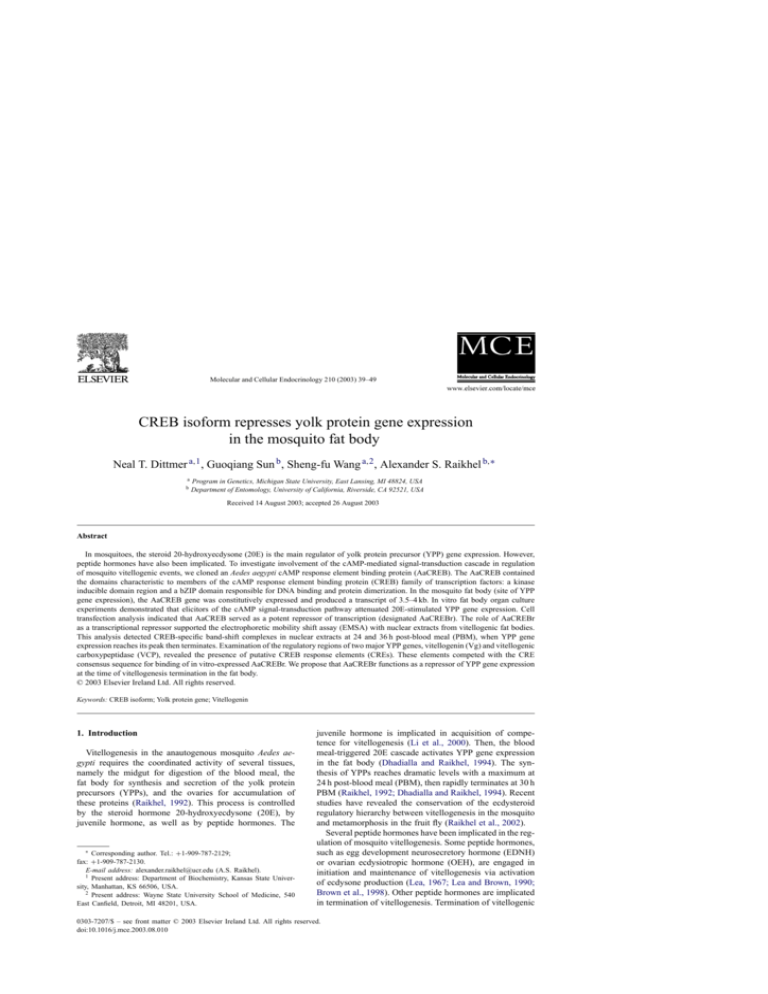
Molecular and Cellular Endocrinology 210 (2003) 39–49
CREB isoform represses yolk protein gene expression
in the mosquito fat body
Neal T. Dittmer a,1 , Guoqiang Sun b , Sheng-fu Wang a,2 , Alexander S. Raikhel b,∗
a
b
Program in Genetics, Michigan State University, East Lansing, MI 48824, USA
Department of Entomology, University of California, Riverside, CA 92521, USA
Received 14 August 2003; accepted 26 August 2003
Abstract
In mosquitoes, the steroid 20-hydroxyecdysone (20E) is the main regulator of yolk protein precursor (YPP) gene expression. However,
peptide hormones have also been implicated. To investigate involvement of the cAMP-mediated signal-transduction cascade in regulation
of mosquito vitellogenic events, we cloned an Aedes aegypti cAMP response element binding protein (AaCREB). The AaCREB contained
the domains characteristic to members of the cAMP response element binding protein (CREB) family of transcription factors: a kinase
inducible domain region and a bZIP domain responsible for DNA binding and protein dimerization. In the mosquito fat body (site of YPP
gene expression), the AaCREB gene was constitutively expressed and produced a transcript of 3.5–4 kb. In vitro fat body organ culture
experiments demonstrated that elicitors of the cAMP signal-transduction pathway attenuated 20E-stimulated YPP gene expression. Cell
transfection analysis indicated that AaCREB served as a potent repressor of transcription (designated AaCREBr). The role of AaCREBr
as a transcriptional repressor supported the electrophoretic mobility shift assay (EMSA) with nuclear extracts from vitellogenic fat bodies.
This analysis detected CREB-specific band-shift complexes in nuclear extracts at 24 and 36 h post-blood meal (PBM), when YPP gene
expression reaches its peak then terminates. Examination of the regulatory regions of two major YPP genes, vitellogenin (Vg) and vitellogenic
carboxypeptidase (VCP), revealed the presence of putative CREB response elements (CREs). These elements competed with the CRE
consensus sequence for binding of in vitro-expressed AaCREBr. We propose that AaCREBr functions as a repressor of YPP gene expression
at the time of vitellogenesis termination in the fat body.
© 2003 Elsevier Ireland Ltd. All rights reserved.
Keywords: CREB isoform; Yolk protein gene; Vitellogenin
1. Introduction
Vitellogenesis in the anautogenous mosquito Aedes aegypti requires the coordinated activity of several tissues,
namely the midgut for digestion of the blood meal, the
fat body for synthesis and secretion of the yolk protein
precursors (YPPs), and the ovaries for accumulation of
these proteins (Raikhel, 1992). This process is controlled
by the steroid hormone 20-hydroxyecdysone (20E), by
juvenile hormone, as well as by peptide hormones. The
∗ Corresponding author. Tel.: +1-909-787-2129;
fax: +1-909-787-2130.
E-mail address: alexander.raikhel@ucr.edu (A.S. Raikhel).
1 Present address: Department of Biochemistry, Kansas State University, Manhattan, KS 66506, USA.
2 Present address: Wayne State University School of Medicine, 540
East Canfield, Detroit, MI 48201, USA.
juvenile hormone is implicated in acquisition of competence for vitellogenesis (Li et al., 2000). Then, the blood
meal-triggered 20E cascade activates YPP gene expression
in the fat body (Dhadialla and Raikhel, 1994). The synthesis of YPPs reaches dramatic levels with a maximum at
24 h post-blood meal (PBM), then rapidly terminates at 30 h
PBM (Raikhel, 1992; Dhadialla and Raikhel, 1994). Recent
studies have revealed the conservation of the ecdysteroid
regulatory hierarchy between vitellogenesis in the mosquito
and metamorphosis in the fruit fly (Raikhel et al., 2002).
Several peptide hormones have been implicated in the regulation of mosquito vitellogenesis. Some peptide hormones,
such as egg development neurosecretory hormone (EDNH)
or ovarian ecdysiotropic hormone (OEH), are engaged in
initiation and maintenance of vitellogenesis via activation
of ecdysone production (Lea, 1967; Lea and Brown, 1990;
Brown et al., 1998). Other peptide hormones are implicated
in termination of vitellogenesis. Termination of vitellogenic
0303-7207/$ – see front matter © 2003 Elsevier Ireland Ltd. All rights reserved.
doi:10.1016/j.mce.2003.08.010
40
N.T. Dittmer et al. / Molecular and Cellular Endocrinology 210 (2003) 39–49
events is essential for an anautogenous female mosquito to
complete the maturation of the first batch of eggs and prepare herself for the next cycle of egg development. It has
been suggested that the oostatic hormone (OSH) produced
and secreted by the ovaries at the end of first vitellogenic
cycle inhibits uptake of YPPs in less developed eggs (Meola
and Lea, 1972; Kelly et al., 1986; Lea and Brown, 1990).
However, involvement of peptide hormones in the termination of vitellogenic events in the fat body has not been
demonstrated. This is despite numerous hallmarks of regulated shut-off of YPP gene expression, secretion of YPP,
and complete remodeling of fat body cells (Raikhel, 1992).
Since peptide hormones are hydrophilic in nature, they are
unable to pass through the lipid bilayer of the cell surface.
Thus, these hormones act by binding to a surface receptor,
triggering a cascade of events that can have a pleiotropic
effect on the cell. The cyclic AMP (cAMP) cascade is one
of the major signal-transduction pathways utilized by cells.
Binding of a hormone to its cognate receptor activates the
enzyme adenylate cyclase which converts ATP to cAMP
via the GTP binding protein (G-protein) complex. cAMP
then acts as the “second messenger” in the cascade, activating protein kinase A (PKA) which in turn phosphorylates a
wide variety of intracellular proteins, including transcription
factors (for recent reviews, see Meyer and Habener, 1993;
Montminy, 1997; Daniel et al., 1998; Sassone-Corsi, 1998;
De Cesare et al., 1999; Shaywitz and Greenberg, 1999; De
Cesare and Sassone-Corsi, 2000).
The transcription factors best characterized for their regulation by PKA are the cAMP response element binding
(CREB) protein (Hoeffler et al., 1988), the cAMP response
element modulator (CREM; Foulkes and Sassone-Corsi,
1992), and activating transcription factor 1 (ATF-1; Hai
et al., 1989). CREB, CREM, and ATF-1 represent a subfamily of a large group of transcription factors known as bZIP
proteins (Meyer and Habener, 1993; Hurst, 1994). Members of the bZIP family share a common structural motif at
their C-terminus: a region rich in positively charged (basic)
amino acids followed by a sequence containing leucines
at every seventh position (a heptad repeat) (Landschulz
et al., 1988; Meyer and Habener, 1993). CREB, CREM,
and ATF-1 show a striking degree of homology in amino
acid sequence and, consequently, all three can bind to the
consensus sequence for the cAMP response element (CRE;
TGACGTCA; Montminy et al., 1986). In addition to the
bZIP region, these proteins have two other domains necessary to function as transcriptional activators: the kinase
inducible domain (KID) and glutamine-rich (Q) flanking
sequences. Most notably is the PKA recognition sequence
RRPSY in the KID, which is phosphorylated on the serine.
In insects, proteins able to bind to CREs have only
been identified from Drosophila: dCREB-A (also known
as BBF-2; Abel et al., 1992; Smolik et al., 1992) and
dCREB2 (also known as dCREB-B; Usui et al., 1993; Yin
et al., 1995). Transient transfections in cell culture have
shown dCREB-A to be a transcriptional activator but not
a mediator of cAMP-stimulated transcription, and indeed
dCREB-A lacks a PKA recognition sequence (Abel et al.,
1992; Smolik et al., 1992). In contrast, dCREB2 appears
to be a homologue of the mammalian CREB and CREM
genes. Drosophila dCREB2 has conserved 50 of the 58
amino acids in the bZIP region, when compared with the
mammalian CREB/CREM proteins, and also contains a
consensus PKA recognition sequence (Usui et al., 1993;
Yin et al., 1995). Several splice variants of dCREB have
been identified using polymerase chain reaction (PCR) and
cDNA library screening (Usui et al., 1993; Yin et al., 1995).
Significantly, the isoform dCREB2-a was shown to be a
PKA-responsive transcriptional activator, while dCREB2-b
a repressor (Yin et al., 1995).
We were interested in the possible role of the cAMP
signal-transduction pathway in regulating vitellogenesis.
Links of this pathway to events in vitellogenesis have already been established. Shapiro (1983) demonstrated that
ovaries incubated with head extracts have a burst in levels
of cAMP. Sappington et al. (1998) were able to induce
uptake of YPPs by the ovaries with forskolin, an adenylate cyclase activator. In contrast, Wang and Telfer (1996,
2000) have demonstrated cyclic nucleotide-induced termination of vitellogenin (Vg) uptake by follicles of the moth
Hyalophora cecropia. In this report, we cloned a homologue
of the CREB/CREM family of transcription factors from
the mosquito A. aegypti. The deduced amino acid sequence
of the cDNA has the characteristic KID and bZIP domains
of this family, and the in vitro expressed protein can indeed
bind to the consensus CRE. Transient transfections in cell
culture demonstrate that this protein can be a potent inhibitor
of PKA-induced transcriptional activation. In support of this
role as a repressor, elicitors of the cAMP signal-transduction
pathway were shown to attenuate transcription of the YPP
gene vitellogenin. Finally, putative CREs were found in
the flanking regions of the Vg (Kokoza et al., 2001) and
vitellogenic carboxypeptidase (VCP; Deitsch and Raikhel,
1993) genes, suggesting the potential roles for these genes
to be regulated by the CREB-like proteins.
2. Materials and methods
2.1. PCR and cDNA library screening
Degenerate primers were designed for PCR based on conserved residues in the bZIP domain of the dCREB2 and human CREB proteins. The forward primer, 5 -AGGTCTAGAARAAYMGIGARGCIGC-3 (where I = inosine, M = A or
C, R = A or G, Y = C or T), was designed from the amino
acid sequence KNREAA and contained an XbaI restriction
site (shown in bold) in its 5 end to facilitate cloning. The reverse primer, 5 -AGAGAATTCTTRTTYTG-RTTYTCIARIACIGC-3 , was designed from the amino acid sequence
AVLENQNK and contained an EcoRI restriction site
(shown in bold) at its 5 end. A vitellogenic-fat body cDNA
N.T. Dittmer et al. / Molecular and Cellular Endocrinology 210 (2003) 39–49
library (Cho and Raikhel, 1992) was used as the template
for PCR under the following conditions: initial denaturation at 95 ◦ C for 4 min followed by 10 cycles at 95 ◦ C for
30 s, 45 ◦ C for 30 s, and 72 ◦ C for 45 s; then 30 cycles at
95 ◦ C for 30 s, 55 ◦ C for 30 s, and 72 ◦ C for 45 s. A band of
112 bp was amplified and cloned into the XbaI and EcoRI
restriction sites of the plasmid pBluescript SK. Sequencing
of the insert confirmed that it encoded for a portion of the
bZIP domain of a mosquito CREB protein. This fragment
was then used to screen the vitellogenic fat body, cDNA
library using standard protocols (Ausubel et al., 1989;
Sambrook et al., 1989). Isolated cDNA clones were sequenced by the W.M. Keck facility at Yale University, using
Taq FS DNA polymerase and fluorescent-dideoxy terminators in a cycle sequencing method, and analyzed using an
automated Applied Biosystems 377 DNA sequencer.
2.2. Northern blot analysis
Poly(A+) RNA was isolated utilizing the QuickPrep
Micro mRNA Purification Kit (Pharmacia Biotech Inc.).
The RNA was fractionated by electrophoresis in 1%
agarose/formaldehyde gels and transferred to nitrocellulose
membranes by conventional capillary blotting. Membranes
were pre-hybridized in a solution of 50% formamide, 5×
SSC (saline-sodium citrate), 50 mM sodium phosphate (pH
6.7), 100 g/ml salmon sperm DNA, and 5× Denhardt’s
solution at 42 ◦ C. A single-stranded, antisense DNA probe
was generated via PCR (Konat et al., 1994) using the clone
pBSAaCREBr and added to the hybridization buffer at a
concentration of 1 × 106 cpm/ml of solution. Following
overnight hybridization, the blot was first washed twice at
room temperature in 2× SSC, 0.1% SDS, then twice at
60 ◦ C in the same buffer, followed by a final wash at 60 ◦ C
in 0.2× SSC, 0.1% SDS. Autoradiography of the blot was
conducted at −80 ◦ C with intensifying screens. This blot
was also hybridized with probes for mosquito actin and
VCP.
2.3. Preparation of fat body nuclear extracts
Nuclear extracts were prepared as described by Miura
et al. (1999) using the low-salt homogenization buffer.
Briefly, 200–300 mosquito abdomens with adhering fat body
tissue were dissected from female mosquitoes 3–5 days
post-eclosion or at various time points after a blood meal.
The tissues were frozen in liquid nitrogen, then ground to
a fine powder with a mortar and pestle. The powder was
then re-suspended in a low-salt buffer (10 mM HEPES pH
7.9, 1 mM EDTA, 10 mM NaCl, 0.6% (v/v) Triton X-100,
4 mM DTT, 1 mM 4-(2-aminoethyl)-benzensulfonylfluoride
(AEBSF), 5 g/ml each of leupeptin, pepstatin, and antipain, 2 mM benzanidine, and 9 g/ml aprotinin) and homogenized in a Dounce homogenizer with a loosely fitted
pestle. The samples were twice subjected to centrifugation,
800 × g for 30 s at 4 ◦ C, to remove cell debris and the su-
41
pernatant transferred to a new, sterile tube each time. The
nuclei were recovered by centrifugation at 15,000 × g for
10 min at 4 ◦ C. The supernatant was discarded and the nuclei were re-suspended in extraction buffer (20 mM HEPES
pH 7.9, 0.2 mM EDTA, 420 mM NaCl, 1.2 mM MgCl2 ,
25% glycerol, 1 mM DTT, 1 mM AEBSF, 5 g/ml each
of leupeptin, pepstatin, and antipain, 2 mM benzanidine,
and 9 g/ml aprotinin) at a concentration of two mosquito
fat body equivalents per microliter of buffer. The samples
were incubated on ice for 20 min, then spun in a microcentrifuge at maximum speed for 5 min. The supernatant was
dispensed in 10 l aliquots (equivalent to 20 mosquito fat
bodies) and stored at −80 ◦ C.
2.4. Electrophoretic mobility shift assay (EMSA)
EMSA was performed using either in vitro synthesized
proteins or nuclear extracts. For in vitro expression of proteins, the clone pBSAaCREBr was created by inserting the
1.25 kb Acc I fragment, containing the entire CREB coding region, into the EcoRV restriction site of pBluescript
SK (Stratagene) with the 5 end of the insert positioned
downstream of the T3 RNA polymerase promoter. Proteins
were synthesized by a coupled transcription and translation
rabbit reticulocyte lysate kit (TnT, Promega) according to
the manufacturer’s directions. One microgram of DNA was
used in a total reaction volume of 50 l. The TnT reactions
were conducted at 30 ◦ C for 2 h, then stored at −80 ◦ C until
needed.
Binding reactions with the in vitro synthesized proteins
were performed in a total volume of 20 l containing 3 l
of the TnT sample, 10 mM Tris–HCl (pH 8.0), 50 mM
NaCl, 1 mM MgCl2 , 0.5 mM DTT, 0.5 mM EDTA, 2 g
poly(dIdC), and 4% glycerol. The samples were incubated
at room temperature for 15 min, then 0.05 pmol 32 P-labeled
DNA probe was added, and incubation was continued for
an additional 15 min. DNA probes were made by annealing together complementary oligonucleotides and labeling
the recessed 3 ends with [␣-32 P]dATP using the Klenow
fragment of DNA polymerase I. The oligonucleotides used
are listed below (only one strand is shown; boldface type
indicates putative binding sites).
SomCRE:
5 -GATCCTTGGCTGACGTCAGAGAGATC-3
VgCRE:
5 -GATCTGCCGAATACGTCATCTTTCGATC-3
VCPCRE1: 5 -GATCACTGTTAATACGTCAGATTTGATC-3
VCPCRE2: 5 -GATCCACCGATTCCGTCATATGTGGATC-3
bZIP2: 5 -ATCGAAATTCTTGAGCAAGTACAATTTGCCCATG-3
The samples were loaded on a 5% non-denaturing polyacrylamide gel (prerun for 1 h) in 0.5× TBE buffer and run
at 10 V/cm. After electrophoresis, the gel was dried and
42
N.T. Dittmer et al. / Molecular and Cellular Endocrinology 210 (2003) 39–49
autoradiographed with an intensifying screen at −80 ◦ C.
Binding reactions with nuclear extracts were performed in a
similar matter using 5 l nuclear extracts in a total reaction
volume of 30 l. When required, the anti-phosphoCREB
antibodies (New England Biolabs) were added at a 1:100
dilution. These antibodies were generated against a short
synthetic peptide centered around serine of the PKA-box in
the KID that has a very high level of conservation. Initial
incubations were carried out on ice for 30 min before the
addition of the labeled DNA probe.
contained 250 ng of the reporter gene pCRE-Luc, 50 ng of
the co-reporter pCMV--galactosidase, 50 ng pcAaCREBr,
and empty pcDNA3.1 vector for a total of 400 ng DNA.
CREB activation was stimulated by cotransfection with
50 ng pFC-PKA. Transfections were performed in triplicate
with Lipofectamine PLUS Reagent (Invitrogen) according
to the manufacturer’s protocol. Five hours after the start
of transfection, the media was replaced with fresh DMEM
supplemented with 10% FBS. The cells were analyzed 36 h
after transfection for enzyme activity using Luciferase and
-galactosidase assay reagents (Promega).
2.5. In vitro fat body organ culture
Mosquito abdomens with adhering fat body, called the fat
body, were dissected from 3- to 5-day-old previtellogenic
females (the ovaries were excluded) and incubated for 4 h in
vitro, as described previously (Raikhel et al., 1997). These
preparations were incubated in the presence or absence
of elicitors: 1 M 20E (Calbiochem), 1 mM 8-Br-cAMP
(Calbiochem), 1 M forskolin (Calbiochem), 1 M 1,
9-dideoxy-forskolin (Calbiochem). Total RNA was extracted
using the guanidine isothiocyanate method from 12 fat
bodies for each sample treatment (Cho and Raikhel, 1992).
Northern analyses were performed on the same amount of
total RNA. Hybridization was carried out as indicated above.
The culture media of each treatment was collected immediately after culturing, and the protease inhibitor mixture
(Roche Molecular Biochemicals) containing a final concentration of 0.1 M aprotinin, 10 M chymostatin, 1 M leupeptin and 0.4 mM AEBSF was added. The debris of fat bodies was removed by centrifugation at 14,000 × g for 30 min.
The culture media were precipitated in 60% (v/v) acetone.
The pellet was dissolved in the SDS loading buffer, and
the equivalent of nine fat bodies was then subjected to the
Western analyses as described by Hays and Raikhel (1990).
2.6. Transient transfection in cell culture
The AaCREB expression plasmid pcAaCREBr was constructed by digesting pBSAaCREBr with EcoRI and XhoI,
and cloning the released insert into the EcoRI and XhoI
restriction sites of pcDNA3.1/Zeo(+) (Invitrogen). The reporter plasmid pCRE-Luc (Stratagene) contains four copies
of the CRE consensus sequence upstream of a synthetic promoter fused to the luciferase gene. The plasmid pFC-PKA
(Stratagene) encodes for the catalytic subunit of PKA. The
vector pCMV--galactosidase is a control vector used to
normalize transfections.
CV-1 cells were maintained in Dulbecco’s Modified Eagle Media (DMEM; Invitrogen) supplemented with 10%
heat-inactivated fetal bovine serum (FBS; Invitrogen).
Undifferentiated F9 cells were maintained as previously
described (Darrow et al., 1990). Transfection and assay
protocols were similar for both cells lines. The day before
transfections, cells were seeded at a density of 8 × 104 cells
per well in 24-well tissue culture plates. Each transfection
3. Results
3.1. Cloning of mosquito CREB cDNA
Using degenerate primers designed based on regions of
high amino acid conservation in the DNA binding and protein dimerization domains (bZIP) of Drosophila dCREB2
and human CREB proteins, the PCR was performed and amplified a 112 bp fragment. Sequencing analysis confirmed
that the PCR product encoded for a portion of the bZIP region similar to that from dCREB. This fragment was then
used to screen and isolate a 4 kb clone from a mosquito vitellogenic fat body cDNA library. This clone had 1.93 kb long
5 - and 1.2 kb long 3 -untranslated regions. The open reading
frame was complete because one stop codon occurred upstream from three start codons at 186, 195, and 223 bp. Comparison of the flanking sequence around start codon against
Kozak’s sequence (CCA/GCC-AUG; Kozak, 1984) indicated that the 223 bp start codon showed the least match,
while the other two showed three of five bases matching. We
assigned the longest open reading frame as AaCREB with
a predicted size of 295 amino acids (Fig. 1). Based on the
SDS-PAGE analysis, the in vitro expression of the AaCREB
cDNA clone produced a 41 kDa protein, which was consistent with the predicted size (not shown). Alignment of the deduced amino acid sequence of AaCREB with the Drosophila
isoform dCREB2 and human CREB demonstrated striking
similarity in the carboxyl-terminal bZIP domain as well as
a reasonable similarity in the so-called activation domain
(Fig. 2). The predicted AaCREB protein had a region containing consensus phosphorylation sites for PKA and the
protein kinase C equivalent to P-box defined in dCREB,
CREM, and ATF-1. Like the P-boxes in human CREB,
Drosophila dCREB2 and CREM, the AaCREB P-box was
located carboxyl terminated to a glutamine-rich region. All
the structural features of AaCREB indicated that AaCREB
was a member of the CRE/CREM family, being the closest
to fruit-fly dCREB2 (blast search results, not shown).
3.2. Northern blot analysis of AaCREB expression
Northern blot hybridization was used to analyze the
mRNA expression profile of AaCREB. Messenger RNA was
N.T. Dittmer et al. / Molecular and Cellular Endocrinology 210 (2003) 39–49
43
GTAGACTCTTTTTCGTGAGGGCTCCCGCCAAACCCCCCGAAAAAAAACCCCGCACGCT
TGCCCGCCCACCGCCGCCACCTCCTCTGGGCACGCTGACCGAACAACGACCAAAATCGCT
ACAACCCTGGCAAAACTGGCGGGCAACTCGCGAGGAGGAGGCGGGCTTTGGCAGCTGAAG
CAGGAGGCCATGGACAACATGGTCGAGGAGAATGGATCCTCCTCGATGGACCCGCTGGGA
M D N M V E E N G S S S M D P L G
58
118
178
238
17
GCATCCGGCGGCGGTTCGTCCGATCACCAACAACAGCACCAACAGCAGCACAGCAGTAGT
A S G G G S S D H Q Q Q H Q Q Q H S S S
298
37
AGTTCGGGGGCGGGGCCAACGTCCCGGCTCAACAACTCCAGTGGGCCCAACGTCGGCGAA
S S G A G P T S R L N N S S G P N V G E
358
57
AATCTCACCTCGTCCGCAAATGTTGTACAAATCCTGCCGCCGTCGCACACCTCCAGTGGC
N L T S S A N V V Q I L P P S H T S S G
418
77
AGCATCCAGGCACAATCAGTCATACAGCAGAACCAGCAATCGGTGATACAAACCGCAGCC
S I Q A Q S V I Q Q N Q Q S V I Q T A A
478
97
GGCCAGATACCTGCACTACCCCGAGGCGTATTATTAGTGTGTAACAAACCTAGCTCAGTC
G Q I P A L P R G V L L V C N K P S S V
538
117
ATTCACACCACGCAAGGCAGTTTGCAGGCTATCCAGATCAAACCAGAGCCGCACGTCGGC
I H T T Q G S L Q A I Q I K P E P H V G
598
137
AGCGGTGGCAGTATCATGACCGATACCAACAGTGACGATACGATGTCCGATGACGAGGCC
S G G S I M T D T N S D D T M S D D E A
658
157
TCGCCAAAGAAGCGAAGAGATTTACTAACACGACGACCCTCCTATCGTAAGATTCTGAGC
S P K K R R D L L T R R P S Y R K I L S
718
177
GACCTCGGCGGAGCGGAAATTGCAAATGCCCATGGCGATGGCTCAGGACTGCATGCGTTA
D L G G A E I A N A H G D G S G L H A L
778
197
GCAGCGACCGGCGGTGGCGTAGTGCAATATACCCAGGCCCAGGATGGTCAAATTTACGTA
A A T G G G V V Q Y T Q A Q D G Q I Y V
838
217
CCTCATCTTTTTCCCAATGCAGTCATCGGCGGCAACGTGCAGCTAGAGGACCAGTCCCGC
P H L F P N A V I G G N V Q L E D Q S R
898
237
AAGCGGGAGATGCGCCTTCAGAAGAACCGGGAAGCAGCCCGCGAGTGTCGGCGCAAGAAG
K R E M R L Q K N R E A A R E C R R K K
958
257
AAGGAATACATCAAGTGCCTGGAGAACCGAGTGGCCGTGTTGGAGAACCAGAACAAAGCC
K E Y I K C L E N R V A V L E N Q N K A
1018
277
CTCATCGAGGAGCTCAAATCCCTCAAAGAGCTCTACTGCCAGCAGAAGAACGATTGAGAT
L I E E L K S L K E L Y C Q Q K N D *
1078
295
GCCGATTGAGAAGAAGAAGACGCAAGAAGACAATAGTCGGCGCTCGTCACGACTACCAAG
TACCATTTCTTGAACTATTACGACTAGGACTTCAACCAACAAAAGCGATGCCGTGGATGT
GGTTTGTTACCAACCAGGGTTCAAAAAAAATCCCCTAAAAGAACGGTAGAC
1138
1198
1249
Fig. 1. Nucleotide and deduced amino acid sequence of AaCREBr. The 4 kb AaCREBr cDNA was sequenced in its entirety and submitted to GenBank
(accession number AY083158); only the 1.25 kb AccI restriction fragment subcloned for in vitro expression is shown here. (A) Nucleotide and deduced
amino acid sequence of AaCREBr. The PKA phosphorylation site is boxed in black with the single-letter abbreviations of the amino acids in reverse
phase. The bZIP domain is boxed in gray with the leucines of the leucine zipper region underlined. Potential phosphorylation sites are circled and were
identified using the MOTIFS computer program (Wisconsin Package, Genetics Computer Group). Numbers on the right represent nucleotide and amino
acid positions.
extracted from the fat bodies of female mosquitoes at various time points before and after the blood meal. After gel
electrophoresis and nucleic acid transfer to a nitrocellulose
membrane, the blot was hybridized with a single-stranded
antisense DNA probe against AaCREB. Two bands of 3.5–4
and 5 kb were detected (Fig. 3). The 3.5–4 kb transcript
was by far the predominant one, and it was detected at all
time points tested, showing the highest levels during the
previtellogenic (post-eclosion) period and the first 12 h after a blood meal. Between 18 and 36 h PBM, a time when
YPP synthesis is at its maximum level in the fat body, the
AaCREB mRNA was at its lowest levels (Fig. 3). The 5 kb
transcript was much less abundant and was only seen at the
time points when the 3.5–4 kb message was at its highest
levels. We have concluded that the 5 kb band was most
likely a result of non-specific binding. For comparison, the
blot had been hybridized with probes for mosquito AaVCP,
an ecdysteroid-responsive YPP gene (Deitsch and Raikhel,
1993), and actin, a constitutively expressed gene.
3.3. AaCREB can bind to CRE and recognize putative
CRE in the 5 regions of two mosquito YPP genes
To investigate the DNA binding ability of AaCREB, EMSAs were performed. The CRE of the rat somatostatin gene
(SomCRE; Montminy et al., 1986) was used as a probe in
44
N.T. Dittmer et al. / Molecular and Cellular Endocrinology 210 (2003) 39–49
(A)
HsCREB: RKREVRLMKNREAARECRRKKKEYVKCLENRVAVLENQNKTLIEELKALKDLYCH-KSD
||||:|| ||||||||||||||||:||||||||||||||| ||||||:||:||| |:|
dCREB2: RKREIRLQKNREAARECRRKKKEYIKCLENRVAVLENQNKALIEELKSLKELYCQTKND
||||:|||||||||||||||||||||||||||||||||||||||||||||||||| |||
AaCREBr: RKREMRLQKNREAARECRRKKKEYIKCLENRVAVLENQNKALIEELKSLKELYCQQKND
(237aa-295aa)
(B)
HsCREB:
dCREB2:
AaCREBr:
* *
** ** ** ***
QKRREILSRRPSYRKILNDLSSDAP
:|||::|:|||||||||:||
QHHRSELTRRPSYNKIFTEISGPDM
: |: ||||||| || :: | ::
KKRRDLLTRRPSYRKILSDLGGAEI
(159aa-184aa)
Fig. 2. Comparison of AaCREBr with Drosophila and human CREB proteins. (A) Alignment of the bZIP domains of mosquito (AaCREBr), Drosophila
(dCREB2; Usui et al., 1993; Yin et al., 1995), and human (HsCREB; Hoeffler et al., 1988) CREB proteins. Vertical lines represent identical amino acids,
colons depict conservative substitutions. (B) Alignment of the sequence surrounding the PKA phosphorylation site of mosquito, Drosophila, and human
CREB proteins. The PKA recognition site is boxed in gray. Asterisks denote residues in contact with the coactivator CBP. Vertical lines and colons are
the same as in (A).
this experiment. As seen in Fig. 4, the in vitro transcript
and translated AaCREB were able to bind to SomCRE.
This binding complex could be competed away with excess
of unlabeled SomCREB DNA, but not by a non-specific
competitor (Fig. 4, lanes 3 and 7). Computational search
of CREs revealed one putative CRE at 1.7 kb upstream of
the transcription start site on the Vg promoter (VgCRE)
and two CREs at 153 bp and 1.7 kb upstream of the tran-
scription start site on the VCP promoter (named VCPCRE1
and VCPCRE2, respectively). All matched six of eight
nucleotides in the CRE consensus sequence, including the
5 -CGTCA-3 core. Using the three CREs containing flanking sequence as competitors, all three CREs were able to
abolish the binding complex SomCRE and AaCREB (Fig. 4,
lanes 4–6). In an additional experiment, direct binding tests
were performed using VgCRE and VCPCRE1. These tests
Fig. 3. mRNA expression profile of AaCREB in the fat body. Northern blot analysis of mRNA prepared from dissected fat bodies at the indicated times:
d, days; h, hours; PE, post-eclosion; PBM, post-blood meal. Panel (A) has 25 mosquito fat body equivalents loaded per lane, and panel (B) has 35
mosquito fat body equivalents loaded per lane. This blot had been previously hybridized with probes for mosquito lipophorin, actin, and vitellogenic
carboxypeptidase (VCP). The bands identified by an asterisk in panel (A) are a result of a residual signal from the VCP hybridization. An RNA molecular
weight marker (in kb) is marked to the left of each panel.
N.T. Dittmer et al. / Molecular and Cellular Endocrinology 210 (2003) 39–49
Fig. 4. AaCREBr binds to CREs in vitro. AaCREBr was expressed in
vitro as described in Section 2. EMSA was performed using the AaCREBr
TNT lysate and labeled SomCRE as the probe. Lane 1, unprogrammed
TnT lysate. Lane 2, AaCREBr TnT lysate. Lanes 3–7, same as lane 2
plus the addition of unlabeled competitor DNA, expressed in molar excess
with respect to the labeled probe. Competitor DNA sequences are: SomCRE, TGACGTCA; VgCRE, ATACGTCA; VCPCRE1, ATACGTCA;
VCPCRE2, TTCCGTCA; bZIP2, CTTGAGCAAT (Dittmer and Raikhel,
1997), which binds the CCAAT/enhancer binding protein (C/EBP) was
used as a non-specific competitor. Bold type indicates matches to the
SomCRE.
revealed that AaCREB could specifically bind to putative
CRE in the 5 regions of two mosquito YPP genes (not
shown). Taken together, these experiments demonstrated that
AaCREB could specially bind to consensus cAMP response
element as well as the potential CREs on the yolk protein
gene Vg and VCP promoter, suggesting its possible role in
the regulation of expression of these genes.
3.4. Vitellogenic fat body nuclear extract contains a
CREB-like factor bound to CRE
To identify the occurrence of the nuclear factor that
binds specifically to CRE during vitellogenesis, we carried out EMSA with nuclear extracts from fat bodies of
pre-vitellogenic and vitellogenic female mosquitoes. As
shown in Fig. 5, the retardation complex was observed
when radioactively labeled SomCRE was incubated with
the nuclear extract from fat bodies at 24 and 36 h PBM, the
time when YPP synthesis begins to terminate, although this
complex was not detected in previtellogenic fat bodies or
45
Fig. 5. CRE binding proteins are present in fat body nuclear extracts.
EMSA was performed with fat body nuclear extracts prepared from the
time points indicated (d PE, days post-eclosion; h PBM, hours post-blood
meal) and incubated with a 32 P-labeled SomCRE as the probe. Ten
mosquito fat body equivalents were used per lane. In vitro expressed
AaCREBr was used as a control for binding. The presence (1:100 dilution),
or absence, of anti-phosphoCREB antibodies is indicated above each lane.
The filled arrowhead marks the shifted DNA/protein binding complex. The
open arrowhead marks the super-shifted complex formed by the addition
of the antibodies.
during the vitellogenic period (3 and 12 h PBM). This binding could be supershifted with anti-phospho-CREB. The in
vitro expressed AaCREB protein could also be recognized
and supershifted with this antibody (Fig. 5). Taken together,
these findings suggest that the phosphorylated CREB-like
protein exists only at the termination stage of vitellogenesis;
most likely it is AaCREB.
3.5. Elicitors of the cAMP pathway inhibit the
vitellogenic response in the mosquito fat body
An in vitro fat body culture provides a good system
to study regulation of gene expression by 20E, mimicking the in vivo response to a blood meal. To explore the
possible role of the cAMP pathway in regulation of YPP
gene expression, mosquito abdomens with adhering fat
bodies were cultured in vitro with two elicitors of this
pathway: the adenylate cyclase activator forskolin and the
cAMP analog 8-Br-cAMP. Consistent with a previous result (Deitsch et al., 1995), 20E was able to activate the Vg
gene expression in the fat body culture and the secretion
of this protein into the culture media. Neither forskolin nor
8-Br-cAMP by themselves were able to stimulate the AaVg
46
N.T. Dittmer et al. / Molecular and Cellular Endocrinology 210 (2003) 39–49
Fig. 6. Repression of AaVg gene expression by elicitors of the cAMP signal-transduction pathway. Fat bodies from 3 to 5 days post-eclosion were
cultured in vitro with various treatments of 20-hydroxyecdysone or adenylate cyclase activator forskolin or cAMP analogue 8-Br-cAMP. The fat bodies
were harvested after 4 h in culture. The nine fat bodies in each sample were used to extract total RNA for Northern analyses of Vg transcript. The
culture media were collected for protein analysis of secreted Vg. Northern blotting of Vg in in vitro cultured fat bodies treated with 8-Br-cAMP with or
without 20E (upper right panel). Western blotting of Vg in vitro cultured fat bodies treated with 8-Br-cAMP with or without 20E (bottom right panel).
Northern analysis of Vg in vitro cultured fat bodies treated with active forskolin, together with 20E (upper left panel). Western blotting of Vg from in
vitro cultured fat bodies treated with forskolin (bottom left panel). Total RNA was used for each lane. rRNA was used as a loading control. Positive
forskolin: functional, biological active forskolin. Negative forskolin: structurally similar but non-functional forskolin.
gene expression as detected by Northern and Western analyses (Fig. 6). However, both elicitors attenuated the AaVg
gene expression stimulated by 20E (Fig. 6). This attenuation was not observed when an inactive form of forskolin
(1,9-dideoxy-forskolin) was used. These findings imply that
the Vg gene expression activated by 20E was blocked at the
transcriptional level when the cAMP pathway was activated,
probably by downstream mediators of the pathway such as
CREB.
3.6. AaCREB represses the CRE-dependent gene
expression in the cell transfection assay
To establish whether or not AaCREB was able to regulate gene expression upon binding the CRE, transient transfection assays were conducted in the African green monkey
kidney and liver cells (CV-1). We used a pVRE-luc construct that contained four copies of consensus CRE upstream
of the alcohol dehydrogenase (Adh) minimal promoter with
Fig. 7. AaCREBr represses CREB-mediated transcriptional activation. CV-1 cells were co-transfected with pcAaCREBr and the reporter plasmid pCRE-Luc,
which contains four copies of the CRE consensus sequence upstream of a synthetic promoter fused to the luciferase gene. Endogenous CREB activity
was stimulated by the addition of pFC-PKA, which encodes for the catalytic subunit of protein kinase A. AaCREBr represses CRE in CV-1 cells (A) and
F-9 cells (B). The reporter plasmid pCRE-Luc was co-transfected with or without AaCREBr expression vector either in the presence of or the absence
of FC-PKA. Cells were harvested for luciferase activity 36 h post-transfection.
N.T. Dittmer et al. / Molecular and Cellular Endocrinology 210 (2003) 39–49
luciferase as a reporter. As shown in Fig. 7A, a five–six-fold
increase of luciferase activity was detected upon induction
of the cAMP pathway with a plasmid containing the catalytic subunit of PKA. This activation was repressed by the
co-transfection of the expression plasmid pAcCREBr.
Similar results were observed in F9 cells (Fig. 7B), the
cell line used to demonstrate the ability of dCREB2-a to
function as a PKA-responsive transcriptional activator (Yin
et al., 1995). Our cell transfection assays utilizing two independent cell lines confirmed that AaCREB functioned as
a repressor inhibiting expression of genes containing CREs
such as mosquito YPP genes. Therefore, AaCREB was designated as AaCREBr.
4. Discussion
In order to begin to elucidate the role of the cAMP
signal-transduction pathway in the regulation of gene expression in the fat body during vitellogenesis, we have cloned
a mosquito homologue of the CREB/CREM transcription
factor. The mosquito clone AaCREBr shares nearly perfect
homology with the Drosophila and mammalian CREB proteins in the DNA binding and protein dimerization (bZIP)
domains but much-reduced homology outside of this region.
Based on comparison with the several Drosophila isoforms
thus described, AaCREBr is most related to dCREB2-d.
The initial characterization of dCREB2-d has reported this
isoform not to be a repressor of gene transcription (Yin
et al., 1995). Transient transfection of the AaCREBr cDNA
into CV-1 cells likewise failed to activate gene transcription of a reporter construct and instead acted as a potent
inhibitor of PKA-mediated transcriptional activation. Presumably, this repression was the result of competition between the exogenous AaCREBr and the endogenous CREB
for binding to CREs. The role of AaCREBr as a repressor is
further strengthened by the demonstration of its repressive
properties in two different cell lines.
Additional support for the role of AaCREBr as a repressor was suggested by the screening of nuclear extracts for
active CREB binding. Although fat body nuclear extracts
were examined using EMSA at several time points both before and after a blood meal, protein/DNA complexes were
detected only at 24 and 36 h after the blood meal. This is the
time when vitellogenesis is in the transition from synthesis
to termination of YPP gene expression. Northern blot analysis has shown that the AaCREBr gene is constitutively expressed throughout vitellogenesis. This pattern of AaCREBr
mRNA further suggests the existence of post-translational
control of this factor. Phosphorylation of AaCREBr at the
onset of termination is the most likely mechanism, reminiscent of previous result in which cyclic nucleotide was
implicated in induction of the termination of vitellogenesis
(Wang and Telfer, 1996, 2000).
Three asymmetrical CREs have been identified in the promoter of the human CREB gene, and it is postulated that this
47
allows for transcriptional regulation, both positive and negative, by CREB and/or CREM isoforms (Foulkes et al., 1991;
Meyer et al., 1993). The identification of putative CREs from
the flanking regions of the AaVg and AaVCP genes, and
the binding to these sequences by AaCREBr in vitro, also
suggests that these genes could be regulated by AaCREBr.
AaCREBr could repress AaVg and AaVCP gene transcription by preventing other transcription factors that
recognize CREs, or overlapping response elements, from
binding to these sites. Interestingly, the putative mosquito
CREs have also shown strong sequence similarity to the
binding sites of another group of bZIP transcription factors,
the PAR subfamily (Drolet et al., 1991; Johnson, 1993;
Hurst, 1994). When the flanking nucleotides were included
in the analysis, VCPCRE1 matched 7 of 10 nucleotides with
RTTACGTAAY, the PAR binding site consensus sequence
(Haas et al., 1995; Falvey et al., 1996). VCPCRE2 and
VgCRE each matched 8 of 10 nucleotides with this consensus. Significantly, one member of the PAR family is the
chicken vitellogenin binding protein (VBP), which binds to
a control element in the promoter of the chicken vitellogenin
II gene (Iyer et al., 1991; Burch and Davis, 1994). When the
amino acid sequence of the basic (DNA binding) region of
the chicken VBP was used to search the Drosophila genome
database (Adams et al., 2000), three matches were found.
One match was the previously identified giant gene, which
binds to two regulatory sequences in the upstream region of
the Krüppel gene (Capovilla et al., 1992), which has similarity to both CREB and PAR response elements. However,
the other two matches represent previously uncharacterized
Drosophila genes: CG17888 (GenBank accession number
AAF50513) shares 82% identity and 91% similarity with
the basic region of VBP, while CG7786 (GenBank accession number AAF58037) shares 64% identity and 88%
similarity with VBP. Both of these are greater than the homology between Giant and VBP. Thus, it is possible that
mosquito members of the CREB and PAR subfamilies of
bZIP proteins may compete for binding to these elements:
an AaVBP homologue which acts as a transcriptional activator and AaCREBr which represses transcription.
Though it is believed that 20E is the main regulator of
YPP gene expression, it is likely that peptide hormones also
play an important role. In particular, it has been suggested
that the OSH produced and secreted by the ovaries at the end
of the first vitellogenic cycle inhibits uptake of YPPs in less
developed eggs (Meola and Lea, 1972; Kelly et al., 1986;
Lea and Brown, 1990). Our data showing that AaCREBr is
active at the time of termination in the fat body suggest that
OSH could be the peptide hormone that serves as a signal to
trigger the signal-transduction cascade activating AaCREBr.
Acknowledgements
We thank Mr. Alan Hays for his excellent technical assistance in mosquito culture, Ms. Aileen McAinsh for editing
48
N.T. Dittmer et al. / Molecular and Cellular Endocrinology 210 (2003) 39–49
the manuscript. This work was supported by the NIH Grant
5 R37 AI024716 to A.S. Raikhel.
References
Abel, T., Bhatt, R., Maniatis, T., 1992. A Drosophila CREB/ATF transcriptional activator binds to both fat body- and liver-specific regulatory elements. Genes Dev. 6, 466–480.
Adams, M.D., Celniker, S.E., Holt, R.A., Evans, C.A., Gocayne, J.D.,
Amanatides, P.G., Scherer, S.E., Li, P.W., Hoskins, R.A., Galle, R.F., et
al., 2000. The genome sequence of Drosophila melanogaster. Science
287, 2185–2195.
Ausubel, F.M., Brent, R., Kingston, R.E., Moore, D.D., Seidman, J.D.,
Smith, J.A., Struhl, K., 1989. Current Protocols in Molecular Biology,
vol. 1. Greene Publishing Associates, New York.
Brown, M.R., Graf, R., Swiderek, K.M., Fendley, D., Stacker, T.H.,
Champagne, D.E., Lea, A.O., 1998. Identification of a steroidogenic
neurohormone in female mosquitoes. J. Biol. Chem. 273, 3967–3971.
Burch, J.B., Davis, D.L., 1994. Alternative promoter usage and splicing
options result in the differential expression of mRNAs encoding for
isoforms of chicken VBP, a member of the PAR subfamily of bZIP
transcription factors. Nucleic Acids Res. 22, 4714–4733.
Capovilla, M.E., Eldon, E.D., Porrotta, V., 1992. The giant gene of
Drosophila encodes a b-ZIP DNA-binding protein that regulates the
expression of other segmentation gap genes. Development 114, 99–
112.
Cho, W.L., Raikhel, A.S., 1992. Cloning of cDNA for mosquito lysosomal
aspartic protease. Sequence analysis of an insect lysosomal enzyme
similar to cathepsins D and E. J. Biol. Chem. 267, 21823–21829.
Daniel, P.B., Walker, W.H., Habener, J.F., 1998. Cyclic AMP signaling
and gene regulation. Annu. Rev. Nutr. 18, 353–383.
Darrow, A.L., Rickles, R.J., Stickland, S., 1990. Maintenance nad use of
F9 teratocarcinoma cells. Methods Enzymol. 190, 110–117.
De Cesare, D., Sassone-Corsi, P., 2000. Transcriptional regulation by
cyclic AMP-responsive factors. Prog. Nucleic Acid Res. Mol. Biol.
64, 343–369.
De Cesare, D., Fimia, G.M., Sassone-Corsi, P., 1999. Signaling routes
to CREM and CREB: plasticity in transcriptional activation. Trends
Biochem. Sci. 24, 281–285.
Deitsch, K.W., Raikhel, A.S., 1993. Cloning and analysis of the locus for
mosquito vitellogenic carboxypeptidase. Insect. Mol. Biol. 2, 205–213.
Deitsch, K.W., Chen, J.S., Raikhel, A.S., 1995. Indirect control of yolk
protein genes by 20-hydroxyecdysone in the fat body of the mosquito,
Aedes aegypti. Insect. Biochem. Mol. Biol. 25, 449–454.
Dhadialla, T.S., Raikhel, A.S., 1994. Endocrinology of mosquito vitellogenesis. In: Davey, K.G., Peter, R.E., Tobe, S.S. (Eds.), Perspectives
in Comparative Endocrinology. National Research Council of Canada,
Ottawa, pp. 275–281.
Dittmer, N.T., Raikhel, A.S., 1997. Analysis of the mosquito lysosomal aspartic protease gene: an insect housekeeping gene with fat
body-enhanced expression. Insect Biochem. Mol. Biol. 27, 323–335.
Drolet, D.W., Scully, K.M., Simmons, D.M., Wegner, M., Chu, K., Swanson, L.W., Rosenfeld, M.G., 1991. TEF, a transcription factor expressed
specifically in the anterior pituitary during embryogenesis, defines a
new class of leucine zipper proteins. Genes Dev. 5, 1739–1753.
Falvey, E., Marcacci, L., Schibler, U., 1996. DNA-binding specificity
of PAR and C/EBP leucine zipper proteins: a single amino acid
substitution in the C/EBP DNA-binding domain confers PAR-like
specificity to C/EBP. Biol. Chem. 377, 797–809.
Foulkes, N.S., Sassone-Corsi, P., 1992. More is better: activators and
repressors from the same gene. Cell 68, 411–414.
Foulkes, N.S., Borrelli, E., Sassone-Corsi, P., 1991. CREM gene: use of
alternative DNA-binding domains generates multiple antagonists of
cAMP-induced transcription. Cell 64, 739–749.
Haas, N.B., Cantwell, C.A., Johnson, P.F., Burch, J.B., 1995. DNA-binding
specificity of the PAR basic leucine zipper protein VBP partially
overlaps those of the C/EBP and CREB/ATF families and is influenced
by domains that flank the core basic region. Mol. Cell. Biol. 15,
1923–1932.
Hai, T.W., Liu, F., Coukos, W.J., Green, M.R., 1989. Transcription factor
ATF cDNA clones: an extensive family of leucine zipper proteins
able to selectively form DNA-binding heterodimers. Genes Dev. 3,
2083–2090.
Hays, A.R., Raikhel, A.S., 1990. A novel protein produced by the vitellogenic fat body and accumulated in mosquito oocytes. Roux’s Arch.
Dev. Biol. 199, 114–121.
Hoeffler, J.P., Meyer, T.E., Yun, Y., Jameson, J.L., Habener, J.F., 1988.
Cyclic AMP responsive DNA-binding protein: structure based on a
cloned placental cDNA. Science 242, 1430–1433.
Hurst, H.C., 1994. Transcription factors 1, bZIP proteins. Protein Profiles
1, 123–168.
Iyer, S.V., Davis, D.L., Seal, S.N., Burch, J.B., 1991. Chicken vitellogenin
gene-binding protein, a leucine zipper transcription factor that binds to
an important control element in the chicken vitellogenin II promoter,
is related to rat DBP. Mol. Cell. Biol. 11, 4863–4875.
Johnson, P.F., 1993. Identification of C/EBP basic region residues involved
in DNA sequence recognition and half-site spacing preference. Mol.
Cell. Biol. 13, 6919–6930.
Kelly, T.J., Masler, P.E., Schwartz, M.B., Haught, S.B., 1986. Inhibitory
effects of oostatic hormone on ovarian maturation and ecdysteroid
production in Diptera. Insect Biochem. 16, 273–279.
Kokoza, V.A., Martin, D., Mienaltowski, M.J., Ahmed, A., Morton, C.M.,
Raikhel, A.S., 2001. Transcriptional regulation of the mosquito vitellogenin gene via a blood meal-triggered cascade. Gene 274, 47–65.
Konat, G.W., Laszkiewicz, I., Grubinska, B., Wiggins, R.C., 1994. Generation of labeled DNA probes by PCR. In: Griffin, H.G., Griffin,
A.M. (Eds.), PCR Technology: Current Innovations. CRC Press, Baton Raton, FL, pp. 37–42.
Kozak, M., 1984. Compilation and analysis of sequences upstream from
the translational start site in eukaryotic mRNAs. Nucleic Acids Res.
12, 857–872.
Landschulz, W.H., Johnson, P.F., McKnight, S.L., 1988. The leucine
zipper: a hypothetical structure common to a new class of DNA
binding proteins. Science 240, 1756–1764.
Lea, A.O., 1967. The medial neurosecretory cells and egg maturation in
mosquitoes. J. Insect Physiol. 13, 419–429.
Lea, A.O., Brown, M.R., 1990. Neuropeptides of mosquitoes. In: Hagedorn, H.H., Hildebrand, J.G., Kidwell, M.G., Law, J.H. (Eds.), Molecular Insect Science. Plenum Press, New York, pp. 147–154.
Li, C., Kapitskaya, M.Z., Zhu, J., Miura, K., Segraves, W., Raikhel, A.S.,
2000. Conserved molecular mechanism for the stage specificity of the
mosquito vitellogenic response to ecdysone. Dev. Biol. 224, 96–110.
Meola, R., Lea, A.O., 1972. Humoral inhibition of egg development of
mosquitoes. J. Med. Entomol. 9, 99–103.
Meyer, T.E., Habener, J.F., 1993. Cyclic adenosine 3 ,5 -monophosphate
response element binding protein (CREB) and related transcriptionactivating deoxyribonucleic acid-binding proteins. Endocrinol. Rev.
14, 269–290.
Meyer, T.E., Waeber, G., Beckmann, W., Lin, J., Habener, J.F., 1993.
The promoter of the gene encoding cAMP-response element binding
protein CREB contains cAMP response elements: evidence for positive
autoregulation of gene transcription. Endocrinology 132, 770–780.
Miura, K., Wang, S.-F., Raikhel, A.S., 1999. Two distinct subpopulations
of ecdysone receptor complex in the female mosquito during vitellogenesis. Mol. Cell. Endocrinol. 156, 111–120.
Montminy, M., 1997. Transcriptional regulation by cyclic AMP. Annu.
Rev. Biochem. 66, 807–822.
Montminy, M.R., Sevarino, K.A., Wagner, J.A., Mandel, G., Goodman,
R.H., 1986. Identification of a cyclic-AMP-responsive element within
the rat somatostatin gene. Proc. Natl. Acad. Sci. U.S.A. 83, 6682–
6686.
N.T. Dittmer et al. / Molecular and Cellular Endocrinology 210 (2003) 39–49
Raikhel, A.S., 1992. Vitellogenesis in mosquitoes. Adv. Dis. Vect. Res.
9, 1–39.
Raikhel, A.S., Deitsch, K.W., Sappington, T.W., 1997. Culture and analysis
of the insect fat body. In: Crampton, J.M., Beard, C.B., Louis, C.
(Eds.), Molecular Biology of Insect Disease Vectors: A Methods
Manual. Chapman & Hall, New York, pp 507–522.
Raikhel, A.S., Kokoza, V.A., Zhu, J., Martin, D., Wang, S.F., Li, C., Sun,
G., Ahmed, A., Dittmer, N., Attardo, G., 2002. Molecular biology of
mosquito vitellogenesis: from basic studies to genetic engineering of
antipathogen immunity. Insect. Biochem. Mol. Biol. 32, 1275–1286.
Sambrook, J., Fritsch, E.F., Maniatis, T., 1989. Molecular Cloning: A
Laboratory Manual, second ed. Cold Spring Harbor Laboratory Press,
Cold Spring Harbor.
Sappington, T.W., Helbling, P., Koller, C.N., Raikhel, A.S., 1998. Activation in vitro of vitellogenin uptake by the oocytes of the mosquito,
Aedes aegypti. Physiol. Entomol. 23, 158–164.
Sassone-Corsi, P., 1998. Coupling gene expression to cAMP signaling:
role of CREB and CREM. Int. J. Biochem. Cell Biol. 30, 27–38.
Shapiro, J.P., 1983. Ovarian cyclic AMP and response to a brain hormone
from the mosquito Aedes aegypti. Insect. Biochem. 13, 273–279.
49
Shaywitz, A.J., Greenberg, M.E., 1999. CREB: a stimulus-induced transcription factor activated by a diverse array of extracellular signals.
Annu. Rev. Biochem. 68, 821–861.
Smolik, S.M., Rose, R.E., Goodman, R.H., 1992. A cyclic AMP-responsive element-binding transcriptional activator in Drosophila
melanogaster, dCREB-A, is a member of the leucine zipper family.
Mol. Cell. Biol. 12, 4123–4131.
Usui, T., Smolik, S.M., Goodman, R.H., 1993. Isolation of Drosophila
CREB-B: a novel CRE-binding protein. DNA Cell Biol. 12, 589–595.
Wang, Y., Telfer, W.H., 1996. Cyclic nucleotide-induced termination of
vitellogenin uptake by Hyalophora cecropia follicles. Insect. Biochem.
Mol. Biol. 26, 85–94.
Wang, Y., Telfer, W.H., 2000. Cyclic nucleotide-dependent protein phorphorylation in vitellogenic follicles of Hyalophora cecropia. Insect.
Biochem. Mol. Biol. 30, 29–34.
Yin, J.C., Wallach, J.S., Wilder, E.L., Klingensmith, J., Dang, D., Perrimon, N., Zhou, H., Tully, T., Quinn, W.G., 1995. A Drosophila
CREB/CREM homologue encodes multiple isoforms, including a
cyclic AMP-dependent protein kinase-responsive transcriptional activator and antagonist. Mol. Cell. Biol. 15, 5123–5130.



